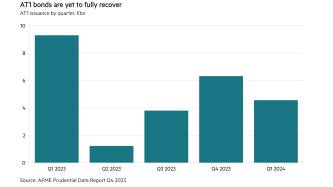It was not entirely plain sailing for Slough Estates when it exchanged five old sterling bond issues for two new ones. But who would not endure a little choppy water when the destination promises interest savings of £11m a year?
Slough Estates is one of the largest property investors and developers in the UK and Europe. At last year-end it had a property portfolio worth £3.9bn, funded by debt of about £1.7bn. That broke down into £963m in long-term sterling bond issues, mostly unsecured, £383m in bank facilities, $460m in US private placements and £135m of dollar and euro-denominated domestic mortgages.
“We have a diversified funding base, borrowing in currencies that match the asset base,” explains Trevor Mant, Slough Estates’ group treasurer. “And, as property is a long-term business, we have a natural appetite for long-term, fixed-rate debt.”
Important aims
One reason for the bond exchange was to lengthen the average remaining life of the company’s issued debt. At the end of 2004 it stood at 9.7 years, compared with 11.3 years for the lease portfolio before break clauses. The existing issues were mostly illiquid and low value, with coupons of 10% and above. Other important aims, therefore, were to reduce the cost of money and with it the group’s annual interest charge; to consolidate issue sizes; and to modernise the documentation.
“We also wanted to exit the only secured funding on the UK balance sheet,” Mr Mant adds, referring to £40m in 11.25% debentures due in 2019.
With UBS, Barclays Capital and Royal Bank of Scotland as advisers, Slough Estates drew up its plans. These proposed the exchange of three bonds maturing in 2007, 2009 and 2012 for a single one due in 2018, and the exchange of two others due in 2017 and 2019 (the aforementioned debentures) for one due in 2035. The latter would be the longest unsecured public deal in the UK property sector.
Quest for endorsement
The Association of British Insurers (ABI) was asked to convene a special committee to consider the proposals. These included carrying out the exchange at market value, but with an ‘early bird’ incentive for bondholders who voted yes. The company wished any future early redemptions to be computed relative to European Investment Bank yields rather than gilts. At the same time, it was offering to include a change of control covenant, not only in the new bonds but also in those other sterling bonds that were not part of the exchange. There was a cash alternative for investors who could not, or would not, accept the changed duration.
It was hoped that ABI endorsement would smooth the transaction’s launch, but it quickly became clear that the necessary unanimity would not be forthcoming. Of the four unrelated investors on the ABI committee, two supported the deal, and one appeared content to cash out.
“One, however, viewed the whole concept as an early redemption exercise on the cheap, which it was not,” Mr Mant recalls. “We really did want to replace the old bonds with current-value new bonds. But we were left with the difficult decision of whether to drop the whole thing or proceed without ABI approval.”
Encouraging support
The proposals had the support of 75% of the ABI committee, which the company found encouraging. “And we had the three major sterling investment banks all saying it was a good, fair deal for all parties,” says Mr Mant. “So we decided to launch to market anyway and let all investors vote on the proposals.”
A roadshow took the deal to investors in London and Scotland in May. The feedback was generally positive, though some investors were not attracted by the extended maturities on offer and opted to take the cash. There was also some unease about there being incentives for those who supported the transaction and not for those who did not.
“We took the pragmatic view that we would pay the incentive to anyone who voted by the deadline, whether in favour or not,” Mr Mant says. “We also decided to increase the new issue spread on the long bond by 5 basis points to 150bp over gilts, to achieve greater take-up for the new bonds rather than the cash option.” The 2018 bond was priced at 125bp over gilts.
Strategy succeeds
The strategy worked. All five bondholder groups voted to accept the proposals. Slough Estates issued its two new bonds – £200m of 2018 paper at 5.5% and £100m of 2035 at 5.75%, against the £430m total market value of the old bonds.
“I’m not sure it would have been any easier with the ABI endorsement, though it might have been quicker,” Mr Mant reckons. “Either way, we are delighted with the coupons we achieved, the lowest for any unsecured public issue in the UK property sector. We have reduced our ongoing interest cost by around £11m a year.”











